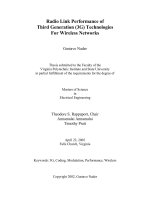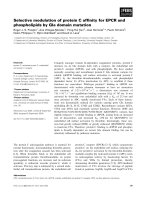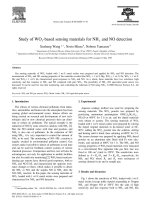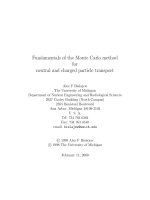Mean performance of fifty genotypes of fennel (Foeniculum vulgare Mill.) for yield and yield attributing traits
Bạn đang xem bản rút gọn của tài liệu. Xem và tải ngay bản đầy đủ của tài liệu tại đây (269.37 KB, 6 trang )
Int.J.Curr.Microbiol.App.Sci (2019) 8(1): 387-392
International Journal of Current Microbiology and Applied Sciences
ISSN: 2319-7706 Volume 8 Number 01 (2019)
Journal homepage:
Original Research Article
/>
Mean Performance of Fifty Genotypes of Fennel (Foeniculum vulgare Mill.)
for Yield and Yield Attributing Traits
R.K. Telugu*, S.K. Tehlan, M. Srikanth and N.C. Mamtha
Department of Vegetable Science, CCS Haryana Agricultural University, Hisar-124004
(Haryana), India
*Corresponding author
ABSTRACT
Keywords
Fennel, Range,
Variability, Yield
and Yield
attributing traits
Article Info
Accepted:
04 December 2018
Available Online:
10 January 2019
Fifty Fennel (Foeniculum vulgare Mill.) genotypes collected from different agro – climatic
zones (Haryana, Rajasthan, Gujarat, Uttar Pradesh and Bihar) for their yield and yield
attributing traits on pooled data (Rabi seasons of 2015-16 and 2016-17) recorded that there
is a wide range of variability for the traits under study. The maximum plant height was
recorded in HF-173 (184.90 cm), whereas the minimum plant height was recorded in JF406 (118.07 cm). The highest number of primary branches per plant and secondary
branches per plant were recorded in HF-167 (12.70) and HF-168 (24.60) respectively.
Early days to 50% flowering was recorded in HF-179 (110.03). The maximum umbels per
plant (71.40) and biological yield per plant (311.95 g) was recorded in genotype HF-169.
And the maximum umbellates per umbel (33.37) seeds per umbellate (25.66), seeds per
umbel (851.83), seed yield per plant (73.17 g), seed yield per ha (65.85 Q), harvest index
(25.17 %) and test weight (9.51 g) were recorded in genotype HF-171.
Introduction
Fennel commonly known as ‘saunf’, an open
pollinated spice crop of temperate and
subtropical regions belongs to the family
Umbelliferae (Apiaceae), has originated from
Mediterranean region, where its high degree
of genetic variability persists (Miranldi, 1999).
It is a diploid species with chromosome
number 2n = 22. Fennel seed consists of 6.3%
moisture, 9.5% protein, 10% fat, 13.4%
minerals,
18.5%
fibre
and
42.3%
carbohydrates and also vitamins like vitamin
C, thiamin, riboflavin, niacin and minerals like
calcium, phosphorous, iron, sodium and
potassium (Bhunia et al.,, 2005). The fennel
seeds are aromatic, stimulant and carminative,
used in diseases of cholera, bile disturbances,
nervous disorders, constipation and dysentery
and also used for control of diseases attacking
lungs, chest, spleen and kidney stones and
menopausal problems (Mohamed and Abdu,
2004). For crop improvement program
presence of genetic variability in to the
population is very important as it provide
chance to pick the genotype having desirable
trait for improvement and it also gives wide
range of options to improve trait of interest.
So, the evaluation of genotypes is important
for further crop improvement program.
387
Int.J.Curr.Microbiol.App.Sci (2019) 8(1): 387-392
Materials and Methods
The study was conducted at Research Farm of
the Department of Vegetable Science,
CCCSHAU, Hisar (Haryana) during the Rabi
seasons of 2015-16 and 2016-17. The
experimental material consisted of fifty
genotypes of fennel in randomized block
design with three replications. Each genotype
is planted at a spacing of 50 cm x 20 cm
(single row of 3.0 m length for each
genotype). The pooled data on thirteen
morphological and yield attributing traits was
taken in five plants which were tagged at
random in all three replications to record the
pooled data and analyzed by the standard
statistical methods.
Results and Discussion
The results of the present investigation are
presented in the Table 1. The plant height
ranged from 118.07 to 184.90 cm with an
overall mean of 149.28 cm. The maximum
plant height was recorded in the genotypes
HF-173 (184.90 cm) followed by HF-171
(183.04 cm), HF-169 (177.02 cm), NDF-42
(169.77 cm), HF-168 (169.22 cm) and NDF28 (166.94 cm) while, the minimum plant
height was recorded in the genotype JF-406
(118.07 cm).
Primary branches per plant varied from 5.08 to
12.70 with overall mean 9.11. The genotype HF167 (12.70) recorded maximum number of
primary branches per plant followed by HF- 168
(12.55), HF-169 (12.10), HF-171 (12.08), HF173 (11.77) and HF-174 (11.20). The minimum
number of primary branches per plant was
recorded in the genotype JF-12 (5.08).
Secondary branches per plant varied from
10.74 to 24.60 with an overall mean 17.00.
The maximum number of secondary branches
per plant was recorded in the genotypes HF168 (24.60) followed by HF-169 (22.07), HF-
167 (21.23), HF-171 (20.90) and HF-173
(20.27). And minimum number of secondary
branches per plant was recorded in the
genotype JF- 12 (10.74).
Days to 50% flowering exhibited in the
population and it ranged from 107.03 days
(HF-179) to 125.80 days (RF-38) with an
overall mean of 115.88 days. The minimum
number of days to 50% flowering by
genotypes like HF-179, HF-178, HF-168, HF169, HF-170, HF-171, HF-167, HF-182, HF173 and HF-180 are considered as early
flowering whereas maximum number of days
taken to 50% flowering by genotypes like RF38, HF-176, RF-21, JK/RM/AF-24, JF-406
and JK/RM/AF-13 are considered as late.
Umbels per plant and the means for umbels
per plant ranged from 23.67 to 71.40 with an
overall mean of 44.74. The maximum
numbers of umbels per plant was recorded in
genotype HF-169 (71.40) followed by HF-171
(69.93), HF-167 (69.10), HF-168 (66.67) and
HF-173 (62.63) and minimum number of
umbels per plant was recorded in JF-12
(23.67).
Umbellates per umbel recorded ranged from
17.93 to 33.37 with an average of 25.26.
Maximum number of umbellates per umbel
was recorded in HF-171(33.37) followed by
HF-169 (32.95), HF-168 (32.55) HF-173
(31.92) and HF-167 (29.39), while, the
minimum number of umbellates per umbel
was observed in JF-12 (17.93).
Seeds per umbellate ranged from 14.93 to
25.60 with an overall mean of 19.52. The
maximum seeds per umbellate was observed
in genotype HF-171(25.60) followed by HF168 (24.17), HF-167 (23.67), HF-169 (22.78),
NDF-28 (22.73), HF-173 (22.65) and HF-180
(22.57), while minimum number of seeds per
umbellate was shown by JF-12 (14.93).
388
Int.J.Curr.Microbiol.App.Sci (2019) 8(1): 387-392
Table.1 Mean values of different characters of 50 fennel genotypes- pooled means of two years
Genotypes
HF-162
HF-163
HF-164
HF-165
HF-166
HF-167
HF-168
HF-169
HF-170
HF-171
HF-172
HF-173
HF-174
HF-175
HF-176
HF-177
HF-178
HF-179
HF-180
HF-182
NDF-28
NDF-38
NDF-39
NDF-41
NDF-42
NDF-43
NDF-44
JF-12
PH
(cm)
143.64
141.27
151.27
137.62
150.70
163.23
164.71
177.02
158.01
183.04
151.37
184.90
161.21
164.35
148.50
158.05
158.11
160.30
162.51
169.22
166.94
149.90
149.90
148.33
169.77
158.39
146.04
120.96
PBP
SBP
DFF
UPP
UTPU
SPUT
SPU
7.95
7.67
7.52
9.57
9.10
12.70
12.55
12.10
9.25
12.08
9.10
11.77
11.20
10.15
9.95
9.30
10.20
10.40
10.47
10.38
9.97
11.05
10.67
8.25
10.80
8.67
9.59
5.08
15.44
15.93
17.40
16.97
16.23
21.23
24.60
22.07
18.70
20.90
18.93
20.27
17.90
16.97
17.87
16.77
16.57
17.30
17.93
17.83
18.24
18.84
15.63
16.57
17.40
16.57
16.97
10.74
112.66
114.47
113.63
115.97
115.77
111.40
110.10
110.20
110.37
111.27
115.87
111.90
114.90
113.67
124.70
114.03
107.17
107.03
112.43
111.50
112.77
119.03
113.07
116.73
119.77
119.20
116.13
112.97
43.44
36.47
41.07
45.50
44.37
69.10
66.67
71.40
47.70
69.93
42.87
62.63
43.83
46.60
46.92
41.57
44.84
43.40
56.17
53.87
47.83
53.64
53.03
44.23
44.84
41.23
45.27
23.67
23.12
24.83
24.97
24.45
23.07
29.39
32.55
32.95
23.80
33.37
23.75
31.92
25.13
24.97
25.95
25.27
24.64
25.83
28.03
27.72
28.57
25.92
27.15
26.65
25.13
26.37
26.05
17.93
17.87
18.20
17.53
18.78
18.70
23.67
24.17
22.78
18.33
25.60
18.80
22.65
17.93
17.77
18.59
18.65
17.90
18.18
22.57
21.59
22.73
21.35
19.13
20.33
21.30
20.80
20.08
14.93
415.20
452.62
437.94
460.47
431.36
694.97
788.37
825.43
436.80
851.83
445.90
725.13
450.10
442.16
480.52
471.53
442.23
470.22
632.93
599.94
651.61
555.62
521.89
545.20
533.55
550.50
524.41
268.90
389
SYPP
(g)
34.03
38.84
42.73
40.80
42.67
63.40
67.67
70.10
43.40
73.17
40.73
66.17
47.14
41.73
38.97
39.85
44.37
39.43
51.57
51.49
51.81
55.77
47.53
46.00
42.80
44.53
43.20
19.04
SYPH(Q)
30.63
34.95
40.73
36.72
38.40
53.45
61.83
62.76
39.72
65.85
39.15
59.55
38.35
37.56
42.82
35.88
41.31
35.49
46.41
46.34
46.63
50.19
38.28
44.68
47.76
41.76
40.38
17.13
BYPP
(g)
236.72
254.09
250.67
265.93
263.58
283.92
293.18
311.95
256.70
290.65
252.76
277.11
241.66
250.88
255.24
264.97
253.04
252.94
272.46
273.67
260.04
259.36
246.36
239.56
236.79
249.34
242.49
210.71
HI
(%)
14.44
15.30
17.23
15.35
16.20
22.38
23.13
22.51
16.99
25.17
16.19
23.84
19.56
16.74
15.37
15.04
17.59
15.65
20.77
20.35
19.93
21.66
19.37
19.20
18.18
18.06
17.86
9.06
TW
(g)
5.19
5.38
6.31
5.55
5.68
7.43
8.53
9.27
6.01
9.51
5.79
8.22
6.41
6.51
6.55
5.84
6.03
6.01
7.16
7.08
7.25
7.37
5.98
6.23
6.76
6.40
6.19
3.47
Int.J.Curr.Microbiol.App.Sci (2019) 8(1): 387-392
JF-382-2
JF-406
JF-421
JF-494
JF-533-2
JF-582
JK-/RM/AF-7
JK-/RM/AF-9
JK-/RM/AF13
JK-/RM/AF19
JK-/RM/AF24
RF-21
RF-38
RF-54
RF-57
GF-11
GF-12
HF-33
HF-39
PF-35
GF-2
R.sourbha
Overall mean
SE(m)
C.D 5%
CV (%)
120.13
118.07
131.10
124.83
130.54
130.91
146.39
149.87
157.52
5.77
6.88
6.52
9.18
6.84
8.49
7.33
8.65
8.97
12.27
13.78
14.37
16.10
14.63
16.77
15.93
15.60
17.33
118.27
119.10
120.40
119.73
119.80
115.50
118.90
119.40
120.00
33.80
27.43
33.80
29.90
35.20
41.10
45.37
47.19
47.67
22.50
19.58
22.47
20.15
23.08
23.40
27.59
26.72
26.73
17.40
16.27
18.20
16.47
17.27
18.20
21.37
20.82
20.43
393.47
319.00
407.82
333.19
400.16
427.32
591.91
557.68
544.63
28.87
21.90
27.97
23.67
26.43
32.33
49.90
50.80
47.02
27.06
20.52
25.17
21.30
23.79
28.18
44.91
45.72
42.31
231.54
224.81
241.67
240.04
235.85
246.02
271.11
275.05
258.96
12.48
9.75
11.72
9.87
11.21
13.13
19.99
19.88
18.19
4.55
3.69
4.42
3.84
4.23
5.17
6.46
6.56
6.44
153.17
8.99
15.37
116.77
42.57
23.83
21.52
513.21
42.40
40.17
261.71
16.25
6.03
147.13
8.07
16.00
121.00
41.73
25.07
18.33
461.52
37.40
30.63
258.57
14.57
5.88
127.07
122.87
149.95
150.63
146.67
141.41
136.23
140.05
144.72
142.57
153.13
149.28
3.84
10.79
4.45
8.55
8.02
8.02
8.38
7.32
7.85
8.33
8.69
9.82
7.90
9.53
9.11
0.24
0.68
4.62
16.53
16.13
16.37
16.47
15.40
17.27
17.87
16.97
16.37
15.80
16.00
17.00
0.61
1.21
4.38
124.17
125.80
118.23
119.80
113.37
115.87
113.70
115.03
118.27
115.57
116.70
115.88
1.08
3.05
1.62
31.70
34.30
37.30
27.50
39.07
44.97
47.97
48.53
44.20
39.50
44.34
44.74
1.24
3.48
4.79
20.93
22.30
20.63
20.13
24.38
26.22
26.73
24.83
25.13
24.97
26.33
25.26
0.90
2.54
6.18
18.90
18.34
17.74
16.87
20.97
19.00
19.10
20.67
20.27
18.42
18.63
19.52
0.71
1.99
6.28
397.64
410.10
366.13
340.42
513.02
501.16
513.73
514.98
511.88
461.15
492.68
501.60
10.60
29.81
3.66
29.74
28.37
35.77
25.10
39.27
43.13
46.47
44.60
44.00
41.10
43.40
42.77
2.12
5.96
8.59
26.76
25.53
35.28
22.59
35.34
40.26
44.73
40.14
40.89
36.99
40.56
39.07
1.22
3.42
5.40
249.72
253.43
246.04
253.11
266.32
275.13
257.22
250.78
252.58
265.99
242.89
256.11
6.26
17.61
4.24
11.93
11.22
14.61
9.92
14.77
15.68
18.09
17.83
17.43
15.54
17.87
16.70
0.81
2.27
8.39
4.82
4.42
5.45
4.23
5.47
6.09
6.26
6.10
6.34
5.71
6.26
6.05
0.13
0.37
3.80
PH; Plant Height, PBP; Primary Branches per Plnat. SBP; Secondary Branches per Plant, DFF; Days to 50 % Flowering, UPP; Umbels per Plant, UTPU;
Umbellates per Umbel, SPUT; Seeds per Umbellate SPU; Seeds per Umbel, SYPP; Seed Yield per Plant, SYPH; Seed Yield Per ha, BYPP; Biologiclal Yield per
Plant, HI; Harvest Index, TW; Test Weight
390
Int.J.Curr.Microbiol.App.Sci (2019) 8(1): 387-392
The seeds per umbel ranged from 268.90 to
851.83 with an overall mean of 501.60. The
maximum number of seeds per umbel was
observed in genotype HF-171 (851.83)
followed by HF- 169 (825.43), HF-168
(788.37), HF-173 (725.13) and HF-167
(694.97). And minimum number of seeds per
umbel observed in JF-12 (268.90).
Test weight ranged from 3.47 g to 9.51 g and
the overall mean was 6.05 g. The maximum
test weight was recorded in genotype HF-171
(9.51 g) followed by HF-169 (9.27 g), HF168 (8.53 g), HF-173 (8.22 g), HF-167 (7.43
g) and NDF-38 (7.37 g). And minimum test
weight was recorded in JF-12 (3.47 g).
From the study we can draw conclusion that
the mean performance of all thirteen
characters under study revealed a great range
of mean values, which concludes that there is
a wide genetic variability among the
genotypes for the traits like plant height (cm),
primary branches per plant, secondary
branches per plant, days to 50% flowering,
umbels per plant, Umbellates per umbel,
seeds per umbellate, seeds per umbel, seed
yield per plant (g), seed yield per ha (Q),
biological yield per plant (g), harvest index
(%) and test weight (g). Therefore there is a
scope for selection of genotypes with
desirable component characters in crossbreeding program. These results corroborate
the findings of Singh and Mittal (2002), Singh
et al., (2004), Patel et al., (2008), Yogi et al.,
(2013), Sengupta et al., (2014), Ghanshyam et
al., (2015) and Mamatha et al., (2017).
Seed yield per plant ranged from 19.04 g to
73.17 g with an overall mean of 42.77 g. The
maximum seed yield per plant was recorded
in genotype HF-171 (73.17 g) followed by
HF-169 (70.10), HF-168 (67.67), HF-173
(66.17) and HF-167 (63.40), while the
minimum seed yield per plant recorded was in
JF-12 (19.04g).
Seed yield per ha ranged from 17.13 Q to
65.85 Q with an overall mean of 39.07 Q. The
maximum seed yield per ha was recorded in
genotype HF-171(65.85 Q) followed by HF169 (62.76), HF-168 (61.83), HF-173 (59.55)
and HF- 167 (53.45). And minimum seed
yield per ha was recorded in JF-12 (17.13 Q).
The biological yield per plant ranged from
210.71 g to 311.95 g with an overall mean of
256.11 g. The maximum numbers of
biological yield per plant was recorded in
genotype HF-169 (311.95 g) followed by HF168 (293.18), HF-171 (290.65) HF- 167
(283.92), HF-173 (277.11), GF-12 (275.13),
JK/RM/AF-9 (275.05) and HF-182 (273.67),
while the minimum number of biological
yield per plant was recorded in JF-12 (210.71
g).
References
Bhunia, S. R., Chauhan, R. P. S. and Yadav,
B. S. 2005. Effect of nitrogen and
irrigation on water use, moisture
extraction pattern, nutrient uptake and
yield of fennel (Foeniculum vulgare).
Indian J. Agron., 50: 73-76.
Ghanshyam, Dodiya, N. S., Sharma, S. P.,
Jain, H. K. and Dashora, A. 2015.
Assessment of genetic variability,
correlation and path analysis for yield
and its components in ajwain
(Trachyspermum ammi L.). J. Spices
and Aromatic Crops, 24(1): 43-46.
Mamatha, N.C., Tehlan, S.K., Srikanth, M.,
Ravikumar, T., Batra. V.K., Karthik
Harvest index ranged from 9.06 % to 24.16 %
and the overall mean value was calculated to
be 16.70 %. The maximum harvest index was
recorded in genotype HF-171(24.16 %)
followed by HF- 173 (23.84 %), HF-168
(23.13 %), HF-169 (22.51 %), HF-167 (22.38
%) and NDF-38 (21.66 %). And minimum
harvest index was recorded in JF-12 (9.06 %).
391
Int.J.Curr.Microbiol.App.Sci (2019) 8(1): 387-392
Reddy, P. and Manoj Kumar Nalla.
2017. Mean performance of 150
fenugreek (Trigonella foenum-graecum
L.) genotypes for yield and yield
contributing traits. Int. J. Pure & App.
Biosci., 5 (3): 1097-1102.
Miranldi, E. 1999. Comparison of the
essential oil from ten Foeniculum
vulgare Mill. samples of fruits of
different origin. Flavour and Fragrance
J., 14: 379-382.
Mohamed, M. A. H. and Abdu, M. 2004.
Growth and oil production of fennel
(Foeniculum vulgare Mill): Effect of
irrigation and organic fertilization.
Biological Agri. and Horti., 22: 31-39.
Patel, D.G., Patel, P.S. and Patel, I.D. 2008.
Studies on variability of some
morphological characters in fennel
(Foeniculum vulgare Mill.), J. Spices
and Aromatic Crops, 17(1):29-32.
Rawat, S. K., Sanjay, K. and Pandey, V. K.,
2013. Determination of genetic
variability, correlation and path analysis
for yield advancement in fennel
(Foeniculum vulgare Mill.). Ind. J.
Ecology, 40(2): 272-275.
Sengupta, S. K., Verma, B. K. and Naidu, A.
K., 2014. Genetic variability study in
fennel (Foeniculum vulgare Mill.). Int.
Sci. J. 1(1): 62-64.
Singh, V. V., Singhania, D. L., Sastry, E. V.
D., Sharma, K. C. and Rajput, S. S.
2004. Character association in half sib
and S1 progenies of fennel (Foeniculum
vulgare Mill.). Published in National
Seminar on New Perspective in
Commercial Cultivation, Processing and
Marketing of Seed Spices and
Medicinal Plants held at S.K.N. College
of Agriculture, Jobner (Rajasthan). pp.
12.
Singh, Y. and Mittal, P. 2002. Studies on
variability, heritability and scope of
improvement in fennel (Foeniculum
vulgare Mill.). Bioved, 13: 7-9.
Yogi, R., Meena, R. S., Kakani, R. K.,
Panwar, A. and Solanki, R. K. 2013.
Variability of some morphological
characters in fennel. Int. J. Seed Spices,
3(1): 41-43.
How to cite this article:
Telugu, R.K., S.K. Tehlan, M. Srikanth and Mamtha, N.C. 2019. Mean Performance of Fifty
Genotypes of Fennel (Foeniculum vulgare Mill.) for Yield and Yield Attributing Traits.
Int.J.Curr.Microbiol.App.Sci. 8(01): 387-392. doi: />
392









